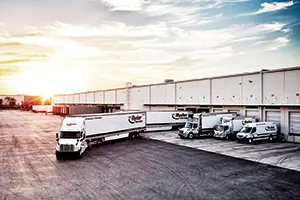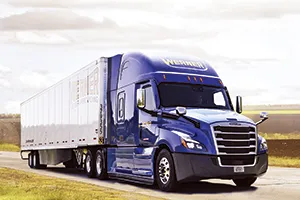Industry Stakeholders Take Aim at Truck Parking Shortage

[Stay on top of transportation news: Get TTNews in your inbox.]
In an industry where conserving time and fuel are paramount, it makes little sense for drivers to wander around in search of a place to park and rest.
According to reports from the American Transportation Research Institute, truck parking has been one of the industry’s top concerns for several years.
In addition, a 2023 report from driver planning mobile app Trucker Path showed that truckers find “no parking available” as often as 23% of the time in various parts of the country. Drivers have expressed concern that the hunt for a place to stop and rest can add as much as 40 minutes of driving and fuel consumption onto a day’s journey.
The problem becomes especially vexing when a driver has reached the point of a necessary stop for federally mandated rest purposes, but still hasn’t identified a safe or available place to park. These are the scenarios that leave drivers no choice but to pull over on the shoulder of a highway ramp.
“Our drivers are reporting experiencing full truck stops and rest areas earlier in the day than they have seen in the past,” said Steve W. Martin, senior vice president of dedicated transportation solutions at Ryder System. “They’re also experiencing a lack of available parking due to closed rest areas and shuttered truck stops. And, due to the growing parking challenge, they’re also seeing reduced parking at or near Ryder locations, which can be an option for parking.”
See the 2023 Top 100 rankings
►Growth Despite Softer Freight Market
►The Truckers of Tomorrow
►Taking Aim at the Parking Shortage
►Managing Regulatory Compliance
►Interactive Map
►Sector Rankings Show Growth, Acquisitions
Sector Rankings
LTL | TL/Dedicated
Intermodal/Drayage
Motor Vehicle/Driveaway
Tank/Bulk | Air/Expedited
Refrigerated | Flatbed/HS
Package/Courier | Mail
Household Goods/Commercial
Ryder Supply Chain Solutions ranks No. 9 on the Transport Topics Top 100 list of the largest for-hire carriers in North America.
The challenge is daunting for less-experienced drivers who are not well versed in truck stop operations, said Angelo Gibson, vice president of operations at Werner Enterprises.
“Rest areas are fairly easy but there’s some nuance to finding truck stops and apps you can use, which you just have to get acclimated to,” he said. “They just want to have a place where they can stop and rest.”
Werner ranks No. 17 on the for-hire TT100.
The public and private sectors have been working in recent years to solve the problem in efforts to help drivers identify parking spots.
To help guide a $1 billion store modernization initiative, truck stop operator Pilot Co. surveyed drivers across North America to learn their top priorities. The answers included clean showers and rest areas, along with a variety of food options and the ability to park and leave quickly. As a result, Pilot has added more than 75,000 parking spots across the continent.
“We’ve used these insights to look at ways to improve the back-lot experience by enhancing layout and adding lighting for increased safety,” said Adrienne Ingoldt, vice president of brand and marketing for Pilot Co. “As we continue to add new locations to our network of travel centers, we’ve been looking at how we can maximize parking and streamline the in-and-out process.”

Some drivers are reporting that truck stops and rest areas are filling up earlier in the day than in the past. (grandriver/Getty Images)
Pilot has introduced a new function for its app that allows drivers to reserve a parking spot. It also offers a page on its website that provides real-time information on available spots.
Ryder offers drivers RyderGyde, an app that lists the location of all 760 Ryder maintenance shops that are available for truck parking. Ryder also encourages drivers to use the apps offered by major truck stops and other resources.
And sometimes Ryder steps in to handle and cover the arrangements.
“In tough, high-traffic areas, we help our drivers by securing paid reserved parking spots or finding safe hotels with available rooms,” Martin said, adding that the company has an arrangement with various hotels to allow drivers free parking if they don’t have any rooms available.
At Werner, Gibson emphasized that despite modern technology assistance, the best thing drivers can do is have a pre-trip plan. He suggested using a hard-copy atlas to map out the assignment.

Ryder offers a mobile app for drivers to find parking at the company’s maintenance locations. (Ryder System)
“I know you don’t hear about atlases much anymore, but with all the technology, they’re a great resource for visualizing the trip and thinking about where you want to stop,” Gibson said.
In the interest of making drivers better informed about available parking, ATRI has worked to develop an app called Park My Truck. The app grabs data from five of the largest truck stop operators and consolidates them so drivers can see what’s available in the areas they are approaching. But Dan Murray, senior vice president of ATRI, said the app cannot solve the biggest problem on the road — the shortage of parking capacity.
“We have estimated that, for every truck parking space, there are 11 trucks that need that space,” Murray said. “These systems, like Park My Truck, are critical to let drivers know where space is available, but at the end of the day, we need a substantial increase in capacity.”
To help address that issue, Evan K. Shelley established an online service known as the Truck Parking Club. The company connects drivers to parking spots in less traditional locations, such as trucking company facilities, CDL schools and properties owned by real estate investors. Truck Parking Club emphasizes secure sites.
“We have some very high-security locations with 24/7 security and electric fences at some of the locations,” said Shelley, the company’s co-founder and CEO. “Those far and away get the majority of bookings compared to something that is less secure.”
State departments of transportation also are helping to keep drivers aware of what is available. Some have partnered with technology provider Drivewyze to aggregate information from various parking spots and feed them to roadside digital displays.

Werner emphasizes the importance of pre-trip planning to help secure parking. (Werner Enterprises)
“[No one needs] to see trucks parked on the side of the road unsafely,” said Doug Johnson, vice president of marketing at Drivewyze. “It’s bad for everybody.”
Fleet operators also are looking to minimize idling and emissions, both to save fuel costs and reduce their environmental impact. That has historically been a challenge as drivers who spend their rest periods in sleeper cabs still need power, but a range of solutions are available.
Ryder’s sleeper tractors have auxiliary power units that burn fuel at one-tenth the normal rate. This allows drivers to shut off their engines during layovers, keeping the tractor at room temperature while providing enough power to run appliances.
Gibson said Werner works with its drivers to ensure they minimize idling.
“Idle reduction is an important topic we stress with our drivers to make sure everyone is doing their part to keep our ESG [environmental, social and governance] initiatives moving forward,” Gibson said. “We coach continuously on ways to reduce idle, and we utilize idle management systems to assist drivers when parked.”
Want more news? Listen to today's daily briefing below or go here for more info:





